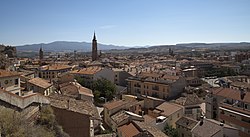Calatayud
Calatayud | |
|---|---|
 | |
 | |
| Country | |
| Autonomous community | Aragón |
| Province | Zaragoza |
| Comarca | Comunidad de Calatayud |
| Judicial district | Calatayud |
| Government | |
| • Alcalde | José Manuel Aranda (PP) |
| Area | |
| • Total | 154 km2 (59 sq mi) |
| Elevation | 530 m (1,740 ft) |
| Population (2014) | |
| • Total | 20,658 |
| • Density | 130/km2 (350/sq mi) |
| Demonym(s) | Bilbilitano, na |
| Time zone | UTC+1 (CET) |
| • Summer (DST) | UTC+2 (CEST) |
| Postal code | 50300 |
| Website | Official website |
Calatayud (Aragonese: Calatayú; 2014 pop. 20,658, declining along the last decade due to migration)[1] is a municipality in the Province of Zaragoza, within Aragón, Spain, lying on the river Jalón, in the midst of the Sistema Ibérico mountain range. It is the second-largest town in the province after the capital, Zaragoza, and the largest town in Aragón other than the three provincial capitals. It is the seat of the comarca of Calatayud.
The city has the title Muy noble, leal, siempre augusta y fidelísima ciudad de Calatayud ("The very noble, loyal, always august and most faithful City of Calatayud").[2] According the vote call for democratic elections in 1977 (the first election after General Franco's regime were held one day before all the rest of Spain, to prepare for a visit by King Juan Carlos I.
Highways and railways
The town is located by the Carretera Nacional N-II highway, the Autovía A-2 and the N-234, among other local roads.
The AVE Madrid–Barcelona high-speed rail line,[3] as well as the RENFE line from Madrid to Barcelona stop in Calatayud.
History
The city was founded on the site of a Celt-Iberian settlement[4] by the Romans with the name Augusta Bilbilis and was the birthplace of the poet Martial in 40 CE.[5] The site of the ruins of Augusta Bilbilis are approximately four kilometers to the north of the modern city of Calatayud.[6] The modern town was founded by the Moors around the Ayyub castle, circa 716 CE.[7]

The name Calatayud came from the Arabic Qalat 'Ayyūb = "Ayyub's fort". The ancient inhabitants of Bilbilis moved to the new site. Occupying a strategic placement between the central meseta of Spain and the Ebro valley the city retained its importance in succeeding centuries. By the eleventh century a substantial Jewish community was present, surviving the reconquista until the expulsion of the Jews from Spain in 1492.[8] The city was conquered from the Muslims by Alfonso I of Aragón in 1119. Many surviving examples of mudéjar church architecture show that the Moorish influence lived on.[9]
During the Peninsular Wars a notable siege of French occupied Calatayud led to its capture by guerillas in 1811.[10] The city was the capital of its own province[11] in 1822–23, during the Trieno Liberal.

The town suffers from sinkholes.
Main sights
This section needs expansion. You can help by adding to it. (June 2010) |
One of the most notable Mudéjar towers of Aragón is the 15th-century bell tower of the collegiate church of Santa María, which was built on the site of a mosque.[12] The Muslim fortress is the biggest and oldest of the Muslim fortresses of the Iberian peninsula. The church of "San Pedro" was founded by Ferdinand II of Aragón and it was there that the first Cortes (Parliament) of Aragon was held in 1411.[13]
Quarters and villages
- Quarters: Huérmeda, Torres and Embid de la Ribera
- Villages: Campiel, Carramolina, Marivella, Ribota, San Ramón and Terrer
Fiestas
- Easter
- Pilgrimage (romeria) in honour of el Cristo de Ribota, May 1
- Saint Íñigo's Day, June 1
- Saint Roch's Day, August 14–16
- Virgen de la Peña, September 8–12
Traditions

There is a popular Spanish song that says (translated) "If you go to Calatayud / ask for Dolores (a popular female name) / she is a very nice girl / fond of make favours" that captures the (traditional) fame of girls in Calatayud. Given that reputation, traditionally boys went to the town in order to "ask for Dolores" to be "favoured" by local girls. Nowadays this tradition has dismissed although in festivities, boys from the surroundings, even from Zaragoza, visit the town with that aim.
See also
- List of municipalities in Zaragoza
- Calatayud (DO)
- Mudéjar
- Comunidad de Calatayud
- Glen Ellyn (sister city)
Notes
- ^ "Instituto nacional de estadística. (National statistics institute)". www.ine.es. Retrieved 2009-05-31.
- ^ "goza-zaragoza-programa-fiestas-calatayud.pdf (application/pdf Object)" (PDF). Ayuntamiento de Calatayud. p. 14. Retrieved 2009-05-31.
- ^ "AVE". Ayuntamiento de Calatayud. Retrieved 2009-05-31.
- ^ "Calatayud: Ciudad de Encuentros". Ayuntamiento de Calatayud (in Spanish). Retrieved 30 September 2010.
- ^ "bjj.2007.14.2.259 (application/pdf Object)". www.eupjournals.com. Retrieved 2009-01-28.
- ^ "Comunidad de Calatayud". CAI Tourism of Aragon. Retrieved 2009-05-31.
- ^ "SpringerLink - Journal Article". www.springerlink.com. Retrieved 2009-01-28.
- ^ "Calatayud". www.jewishvirtuallibrary.org. Retrieved 2009-01-28.
- ^ "Mudéjar Calatayud (ARTEGUIAS)". www.arteguias.com. Retrieved 2009-01-28.
- ^ various (1911). "4". "Bulgaria" to "Calgary". Vol. 4 (11 ed.). Encyclopaedia Britannica. Retrieved 2009-01-29.
- ^ Template:Es icon División provisional del territorio español de 27 de Enero de 1822, the text of the proposed 1822 territorial division of Spain, Instituto de Historia, Consejo Superior de Investigaciones Cientificas (CSIC, Spanish National Research Council). Accessed online 2010-01-03.
- ^ "126491e.pdf (application/pdf Object)" (PDF). unesdoc.unesco.org. Retrieved 2009-05-31.
- ^ "Church of San Pedro de los Francos of Calatayud". CAI Tourism of Aragon. Retrieved 2009-05-31.
External links
- City website
- Local wines
 Calatayud travel guide from Wikivoyage
Calatayud travel guide from Wikivoyage


